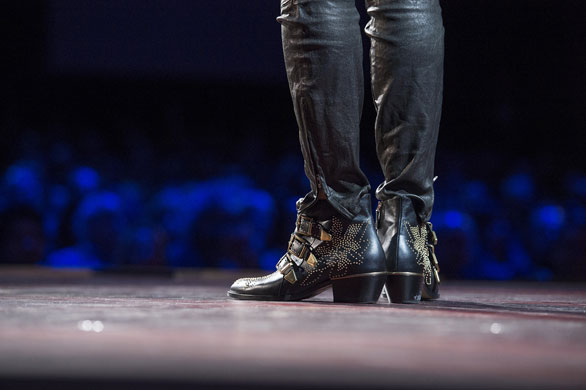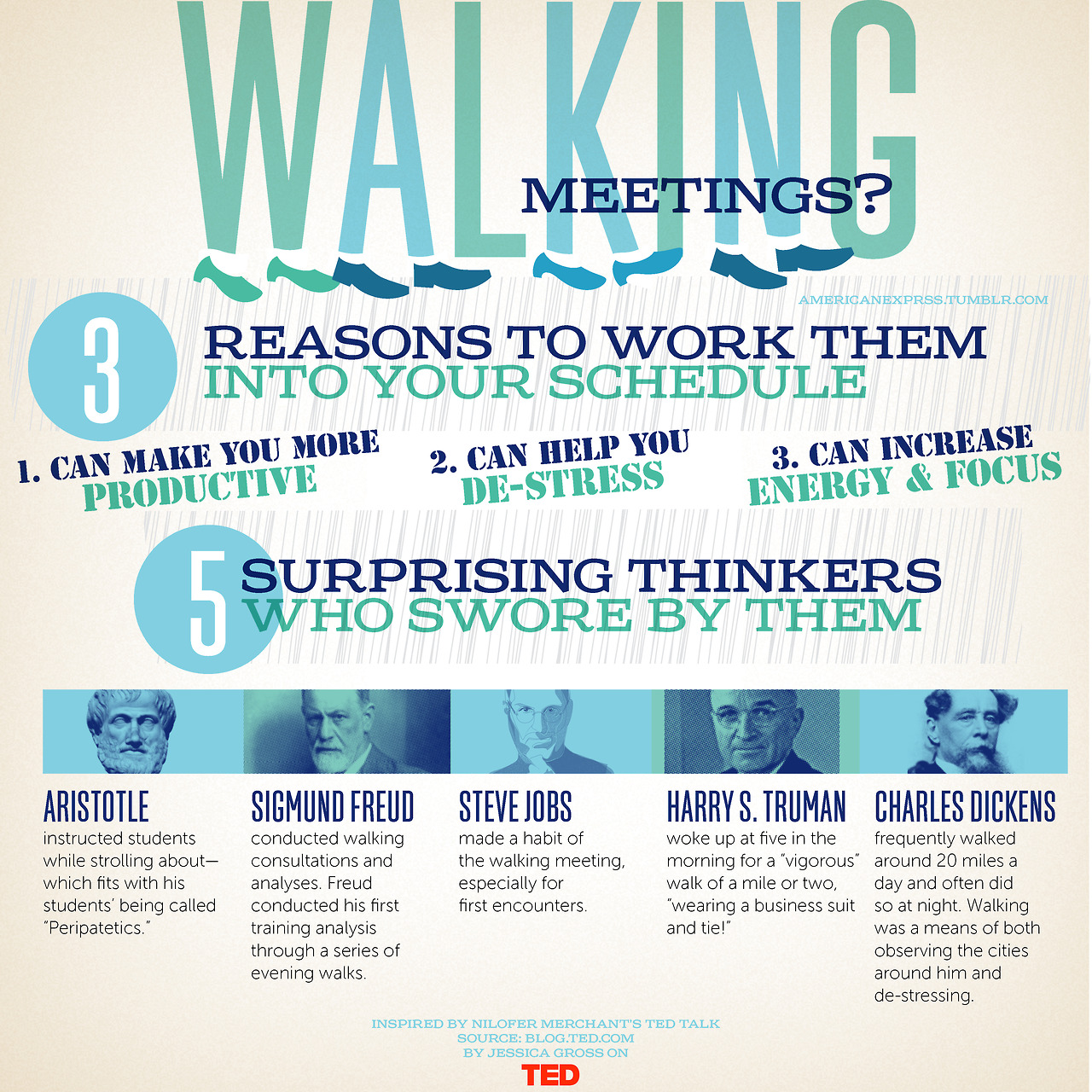In today’s talk, Nilofer Merchant gives a startling statistic: we’re sitting, on average, for 9.3 hours per day—far more than the 7.7 hours we spend sleeping. “Sitting is so incredibly prevalent, we don’t even question how much we’re doing it,” Merchant says.
 Nilofer Merchant: Got a meeting? Take a walk
“In that way, sitting has become the smoking of our generation.”
Nilofer Merchant: Got a meeting? Take a walk
“In that way, sitting has become the smoking of our generation.”
But there are consequences. Physical inactivity, Merchant says, leads to upticks in our risk of breast cancer, colon cancer, heart disease, and type II diabetes.
Merchant’s own habits changed when a colleague couldn’t fit a meeting into her schedule and asked if Merchant could come along on a dog walk instead. Now, she says, “I’ve taken that idea and made it my own.” Instead of meeting in conference rooms, she asks people to go on walking meetings—20 to 30 miles’ worth a week. “It’s changed my life,” she says.
Merchant is carrying on a long tradition of frequent, even ritualistic, walking. Here are some other fans of the amble. Some are walk-and-talkers; others or simply stroll for its own sake.
- Aristotle allegedly instructed students while strolling about—which fits with his students’ being called “Peripatetics.”
. - In August 1910, Sigmund Freud took a four-hour walk with the Austrian composer Gustav Mahler, who had requested an “urgent consultation” via telegraph, according to the BBC. Mahler’s marriage was disintegrating, and he was about to have a breakdown—hence the emergency walk-and-talk with the founder of psychoanalysis. In fact, Freud conducted a number of walking analyses, according to Freud: A Life for Our Time. Another significant example: Freud conducted his first training analysis on Max Eitingon in 1907 through a series of evening walks. Eitingon went to become president of the International Psychoanalytic Association.
. - Steve Jobs made a habit of the walking meeting, especially for first encounters, according to CNNMoney, which quotes from Jobs’ biography: “taking a long walk was his preferred way to have a serious conversation.”
. - Harry S. Truman was a routine-oriented man, and walking was a fundamental part of that routine. According to the University of Virginia’s Miller Center, Truman woke up at five in the morning for a “vigorous” walk of a mile or two, “wearing a business suit and tie!” (This in addition to his frequent midday swimming session in the White House pool, “with his eyeglasses on.”)
. - Charles Dickens “was from childhood an avid, even compulsive, walker,” Sports Illustrated wrote in 1988. (Apparently, the mid-1800s was “the golden age of professional foot racing, or ‘pedestrianism.’” Who knew?) Dickens frequently walked around 20 miles a day—one night in 1857, he logged 30 miles—and often did so at night. Walking was a means of both observing the cities around him and de-stressing. “Dickens found composition to be hard, painful work,” SI writes. “The hours he spent at his desk agitated him tremendously, and walking served as a kind of safety valve.”
Note: After we ran this post, American Express’ Tumblr — a Tumblr designed to motivate and inspire — created the incredible visualization below. Enjoy.
Via American Express’ Tumblr, a Tumblr designed to motivate and inspire.


Comments (133)
Pingback: Walk it out, talk it out: How walking sessions help millennials get unstuck - CareerWise
Pingback: invention idea advice and how to be a creative thinker
Pingback: The Power Of A Daily Walk – WorldStage Development
Pingback: Step away – Craig Medred
Pingback: 23 Ways to boost Employee Wellbeing « Peak Performace Employees
Pingback: How Do I Get My Team To Take Ownership?
Pingback: 4 Scientific Reasons Exercising Is an Entrepreneur's Biggest Competitive Advantage | Webmaster-Box
Pingback: 4 Scientific Reasons Exercising Is an Entrepreneur's Biggest Competitive Advantage – ExploreAbout.com
Pingback: 4 Scientific Reasons Exercising Is an Entrepreneur's Biggest Competitive Advantage | Latest Media News
Pingback: 4 Scientific Reasons Exercising Is an Entrepreneur's Biggest Competitive Advantage by Entrepreneur - Serebral 360º
Pingback: 4 Scientific Reasons Exercising Is an Entrepreneur’s Biggest Competitive Advantage – Charles Milander
Pingback: Channeling Fear to Make Sh*t Happen - permissionLESS -
Pingback: How to increase productivity WITHOUT going crazy - Productivity - Lifelette
Pingback: Tips for boosting meeting productivity - My Annapolis Office - Blog
Pingback: Inc. Southeast Asia
Pingback: 天才たちも実践している「歩く」ことをお勧めする5つの理由
Pingback: Inc. Southeast Asia
Pingback: All That In A Walk? | World Stage Development
Pingback: 19 Surefire Ways to Boost Employee Wellbeing - Best Practice in HR
Pingback: Why Top Leaders Walk and Talk - Brave HQ